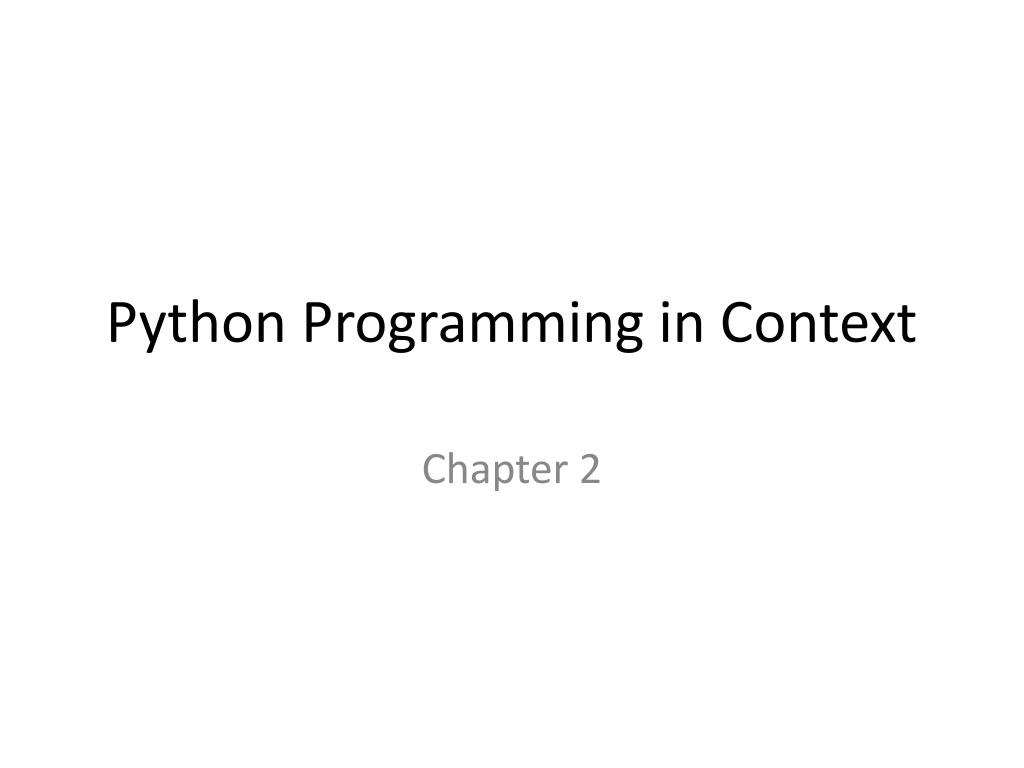Python Programming in Context Chapter 2
In this chapter, we delve into how computers can solve real problems using Python. We explore numeric expressions, variables, assignments, the accumulator pattern, and the math library. Additionally, we look into simple iteration patterns, selection statements, and using random numbers to estimate areas. The chapter covers the significance of the mathematical constant PI, the Archimedes approach, functions, and the accumulator pattern. Examples and figures provide a visual understanding of the concepts discussed.
Download Presentation

Please find below an Image/Link to download the presentation.
The content on the website is provided AS IS for your information and personal use only. It may not be sold, licensed, or shared on other websites without obtaining consent from the author.If you encounter any issues during the download, it is possible that the publisher has removed the file from their server.
You are allowed to download the files provided on this website for personal or commercial use, subject to the condition that they are used lawfully. All files are the property of their respective owners.
The content on the website is provided AS IS for your information and personal use only. It may not be sold, licensed, or shared on other websites without obtaining consent from the author.
E N D
Presentation Transcript
Python Programming in Context Chapter 2
Objectives To understand how computers can help solve real problems To further explore numeric expressions, variables, and assignment To understand the accumulator pattern To utilize the math library To further explore simple iteration patterns To understand simple selection statements To use random numbers to approximate an area
What is PI? Ratio of circumference to diameter 3.1415926535897932384626433832795028841 9716939937510... math.pi from the math module
The Archimedes Approach Use many sided polygon to approximate circumference of a circle. Requires a bit of geometry
Function A name for a sequence of actions Can return a value
Listing 2.1 def functionName(param1,param2,...): statement1 statement2 ... return expression
Listing 2.2 import math def archimedes(numSides): innerangleB = 360.0/numSides halfangleA = innerangleB/2 onehalfsideS = math.sin(math.radians(halfangleA)) sideS = onehalfsideS * 2 polygonCircumference = numSides * sideS pi = polygonCircumference/2 return pi
Accumulator Pattern >>> acc=0 >>> for x in range(1,6): acc = acc + x
Leibniz Formula Summation of terms Use accumulator pattern to add up the terms More terms makes the approximation better
Listing 2.3 def leibniz(terms): acc = 0 num = 4 den = 1 for aterm in range(terms): nextterm = num/den * (-1)**aterm acc = acc + nextterm den = den + 2 return acc
Wallis Formula Product of terms Use accumulator pattern again This time multiply instead of add Need to initialize with 1 not 0
Listing 2.4 def wallis(pairs): acc = 1 num = 2 for apair in range(pairs): leftterm = num/(num-1) rightterm = num/(num+1) acc = acc * leftterm * rightterm num = num + 2 pi = acc * 2 return pi
Monte Carlo Simulation Use random numbers to compute an approximation of pi Simulation of a special game of darts Randomly place darts on the board pi can be computed by keeping track of the number of darts that land on the board
Selection Statements Ask a question (Boolean Expression) Based on the answer, perform a task
Listing 2.5 import random import math def montePi(numDarts): inCircle = 0 for i in range(numDarts): x = random.random() y = random.random() d = math.sqrt(x**2 + y**2) if d <= 1: inCircle = inCircle + 1 pi = inCircle/numDarts * 4 return pi
Listing 2.6 import random import math import turtle def showMontePi(numDarts): wn = turtle.Screen() drawingT = turtle.Turtle() wn.setworldcoordinates(-2,-2,2,2) drawingT.up() drawingT.goto(-1,0) drawingT.down() drawingT.goto(1,0) drawingT.up() drawingT.goto(0,1) drawingT.down() drawingT.goto(0,-1) circle = 0 drawingT.up()
Listing 2.6 continued for i in range(numDarts): x = random.random() y = random.random() d = math.sqrt(x**2 + y**2) drawingT.goto(x,y) if d <= 1: circle = circle + 1 drawingT.color("blue") else: drawingT.color("red") drawingT.dot() pi = circle/numDarts * 4 wn.exitonclick() return pi

